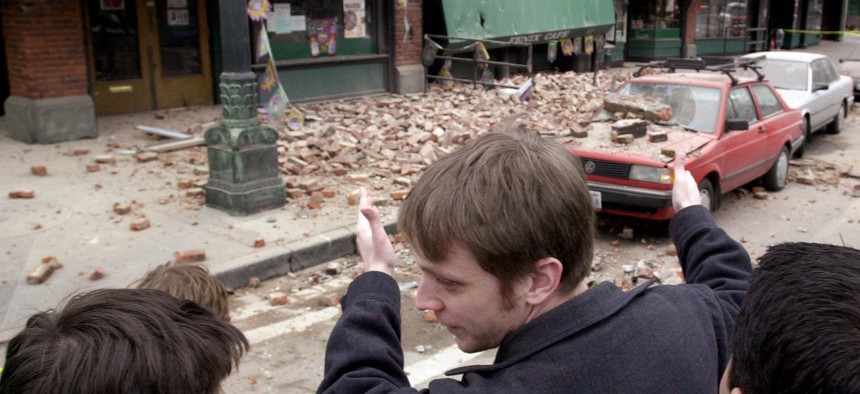As a High-Tech Quake Alert System Takes Shape, There’s a Lower-Tech Way to Save Lives

Bricks from damaged buildings fell on the streets in Seattle's Pioneer Square neighborhood following a Feb. 28, 2001 earthquake centered near Olympia, Washington. Elaine Thompson / AP File Photo
Many West Coast localities still struggle with certain types of dangerous buildings.
Friday’s magnitude 7.2 earthquake in the Mexican state of Oaxaca was another opportunity to demonstrate the benefits of an earthquake early-warning system, which in some seismic events, can send an alert ahead to cities before damaging waves can reach them. That means that in a place like Mexico City, which is built atop the weak soils of a former lakebed, people there had an approximately 1-minute warning to move outdoors and away from buildings or take shelter in a sturdy location before the shaking started.
Fortunately for Mexico City, the impacts from Friday’s quake were minimal compared to more damaging earthquakes in September with epicenters closer to the capital, killing several hundred people there and surrounding states.
While places like Japan and Mexico have deployed earthquake early-warning systems, the U.S. has been sluggish in developing one for quake-prone areas along the West Coast.
As one Los Angeles-based observer tweeted following Friday’s quake in Mexico: “The amount of money it takes to develop an earthquake early warning app is absurdly [and] infuriatingly small.”
ShakeAlert, a quake early-warning system under development by the U.S. Geological Survey in partnership with major West Coast universities, has been taking shape in recent years, but there currently isn’t a way to widely distribute quake early-warning alerts to the general public when seconds matter. But that is likely to change relatively soon in some areas.
As Route Fifty reported in November, the city of Los Angeles put out a request for proposals for an earthquake early-warning app capable of relaying alerts to the public via smartphones and other methods.
While the advances in ShakeAlert are very promising, earthquake early-warning systems are less useful the closer one is to an epicenter. While Los Angeles, for instance, would get an approximately 1-minute warning in a major seismic event that begins 160 miles away along the southern San Andreas Fault, it would only have a few seconds of warning from a quake originating on one of the many smaller faults under the city itself.
But there’s a comparatively lower-tech way to better ensure people aren’t killed or seriously harmed in a major earthquake: Design buildings and infrastructure in ways to sustain major shaking and retrofit older vulnerable structures—especially unreinforced brick and masonry buildings—to make them less likely to fail.
While some cities, like Los Angeles, San Francisco and Santa Monica in California, have taken more aggressive steps to mandate seismic upgrades for vulnerable buildings, others in West Coast states have lagged behind.
Seattle, the Pacific Northwest’s largest city, continues to struggle with approximately 1,100 unreinforced brick and masonry structures, many of them historic buildings lining commercial corridors and clustered in older neighborhoods. That includes many buildings in Pioneer Square, built in the late 19th century atop loose landfill that’s vulnerable to liquefaction that amplifies shaking.
As The Seattle Times reported this weekend, the city has been slow to take action thanks to difficulties many property owners say they face making costly structural upgrades.
Legislation to require retrofits in Seattle was expected by early 2013 but has been repeatedly postponed. Instead, officials commissioned an economic analysis and ordered up yet another building inventory, the ninth such count since the 1970s.
In August, the advisory committee again recommended mandatory retrofits in an almost word-for-word reiteration of its 2013 report.
Draft legislation on retrofitting vulnerable buildings in Seattle isn’t expected until 2019, The Seattle Times reported.
In Southern California, cities in the Inland Empire east of Los Angeles have struggled with retrofitting vulnerable structures, too. Earlier this month, the Los Angeles Times examined the risk in places like San Bernardino, Pomona, Redlands and Riverside where there are as many as 640 buildings that are known to be dangerous “but remain unretrofitted despite decades of warnings.”
While economically struggling owners of vulnerable buildings are one challenge, the L.A. Times found plenty of others:
Poor data upkeep. Building chiefs who stick around for only a few years. Little, if any, public pressure. In dozens of interviews and records requests, The Times found a trail of starts and stops by officials in each city to identify and update lists of old brick buildings. One list dated back 27 years; others were marked by hand or indecipherable.
Like Los Angeles, cities in the Inland Empire not only face significant risk from quakes along the San Andreas Fault, but those that originate on less-famous but still menacing faultlines, like the San Jacinto Fault, which sometimes prompts more worry from seismologists and emergency management officials.
Michael Grass is Executive Editor of Government Executive’s Route Fifty and is based in Seattle.
NEXT STORY: Stop Saying 'Smart Cities'






